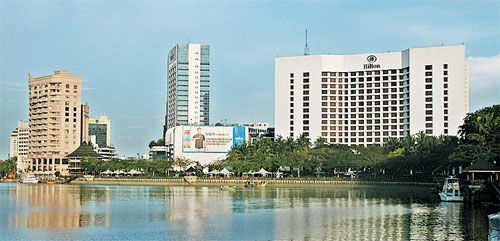
LIKELY AID: Photo shows a view of Kuching city’s waterfront. Sarawak can act as a third-party to slave the rising tensions in Sabah.
The Sabah incident has instigated an unfortunate wave of ground-up acrimony in two prominent Asean nations – unfortunately because it whittles down at the foundation of an already intrinsically disparate group that is a central clog in global growth; evidently acrimonious because of the parading caskets of the fallen and scores of other preventable deaths.
The claims exhumed by -styled Sulu Sultan Jamalul Kiram III over Sabah serve as a vivid reminder that the 10-nation Asean bloc has disturbingly potent skeletons in the closet that can ebb away at the economic credibility of the US$2.3 trillion powerhouse.
For all its economic prowess, the factious nature of Southeast Asian politics – both visible through infighting and international conflicts – has the ability to offset intra-trade, bilateral communication and tourism, ultimately fraying the fabric of the Asean dream.
Directly in Sarawak’s backyard of eastern Borneo, tensions are at times equally as palpable as if the incident had occurred within the state, namely because of the showering attention the bloodiest of the conflict had gotten in national and local media.
As an observer, Sarawak can act as a third-party to salve the rising tensions, but in order to do this Sarawakians must not succumb to the kind of myopic tendencies that have now geared the Philippines to take a more defined stance.
It is important for Sarawak to act as a mediator in this sense, kneading the bruises of the situation through clear-headed discussions that inform people of just how crucial maintaining healthy bilateral sentiment is.
Resulting bias against Filipino visitors, both on the tourism and business level, would bring back hopes of sound integration a notch. Treating the incident as isolated while maintaining a business outlook that promotes trade in the face of ongoing political dialogue is how Sarawak can act as a leader on Borneo.
There are doubtless challenges to mount in achieving this goal. Despite the incident being far-flung from Kuala Lumpur and Manila, ground-up parochialism has engendered jingoist sentiment, prodding governments to make political gestures to appeal to their respective electorates – especially crucial during the precarious election year in both Malaysia and the Philippines.

EASING TENSION: Photo shows scenic view of Kota Kinabalu, Sabah. It is crucial for the tension in Sabah to be settled in a rational manner.
Stepping into a cab in Manila one week ago, my Catholic taxi driver, who was born in the capital told me, “Sabah belongs to the Philippines. It is ours.”
While this is a sentiment not carried by the upper-middle class in Makati, Manila’s financial district, it is apparently an interpretation of some Filipinos that has caused enough noise to give the central government headaches.
Acting on cue, the Philippine Department of Foreign Affairs recently called on all government agencies of the nation to no longer refer to Sabah as part of Malaysia due to the Royal Sultan of Sulu’s pre-existing claims.
Pointing to a 2008 memorandum, Foreign Affairs Spokesman Raul Hernandez said that the request was an ‘existing regulation’ and must be complied with by all government departments, agencies, and instrumentalities.
On an insidious note, unconfirmed rumours – and specifically just that – abound that Aquino’s opposition armed the Sulu rebels with the intent of spurring chaos in the lead up to mid-term elections on May 13.
In response to the ongoing events, President Benigno Aquino III announced that he would spend his Holy Week vacation to “draw up a peaceful (solution) to Sabah claim” instead of on retreat in Baguio City now that his administration had taken its new position.
Indeed, any gestures made to mitigate further damage are not to be overlooked, whilst the region find itself in an every deepening schism. Observers need only look to other examples of deteriorating bilateral relations in Asean to see the damage at the cross hair – as well as the solutions that have been found.
Thailand and Cambodia have had a rollercoaster history, underscored by their on-again, off-again bickering claims over a clutch of temples on Cambodia’s northern border.
Yet the two nations have witnessed increased bilateral trade and investment, with Thailand business associations promoting investment deals in their eastern neighbour as a destination where manufacturing is cost-effective and cultural norms similar – all this in spite of the festering temple incident.
Here is how Sarawak can guide Sabah forward by example. If Malaysian states continue to promote trade with the Philippines through their respective associations, then Asean will stick to what it does best while leaving the politics to those locked away on weekends.
